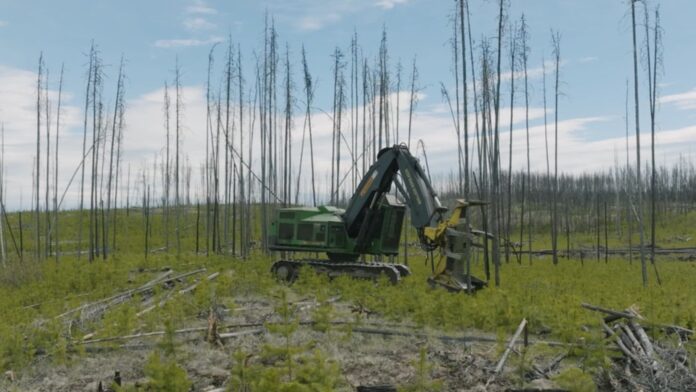Central Chilcotin Rehabilitation Ltd (CCR) is busily working on their newest endeavour.
Crews are engaged in another large scale treatment area along Palmer Road in the Cariboo Chilcotin 90 minutes West of Williams Lake.
“What we are doing is reducing future wildfire risk by removing the fuel.” Percy Guichon, Executive Director of CCR said, “This area was part of the 2017 Hanceville Plateau fire and a lot of these stands have been killed, mostly pine. What we’re doing is removing that fuel loading through our logging equipment and bringing those trees to a central location where we chip it up to utilize that fibre to sell mostly to Cariboo Pulp Mill in Quesnel and also supply fibre to Drack’s pile plant in Williams Lake and Atlantic Power as well.”
The Palmer Project is addressing two key challenges that arose after the devastating 2017 wildfires, extreme fuel loading of dead, mature trees and excessive natural regeneration of new trees, which will further result in the area being ripe for another catastrophic wildfire in the future.
Guichon said CCR learned from the Pressy Lake Pilot Project South of 100 Mile House on the North end of the Elephant Hill wildfire.

“That was more of a mixed stand primarily fir. The Palmer Project location is primarily pine so we’ve learned a lot and become more efficient in our operations so we’re able to utilize more fibre, we’re able to reduce our cost and provide an acceptable rate to our clients.”
Central Chilcotin Rehabilitation has been operating in the Palmer Road area since Spring and Guichon noted that there are so many of these stands of trees as far as the eye can see. (The Hanceville and Plateau fire was 800,000 hectares)
Using specialized forestry equipment, their team started with strategically planning the prescription for the treatment of the area, designing buncher and skidder trail patterns that allow machines to roll over small trees helping to space out the trees while harvesting the burnt trees.
Daniel Persson, Registered Professional Forester and CCR’s Forestry Superintendent said, “We’re improving both forest health and operational efficiency. By treating the site in a smart and strategic way, we’re creating longer-term value, not just for First Nations communities and industry, but for the environment too.”
Guichon said the Palmer Project sustains about 45 jobs directly in the bush and we also help maintain the employment levels at these other secondary manufacturing plants.
Something going on in the Cariboo you think people should know about?
Send us a news tip by emailing [email protected].










